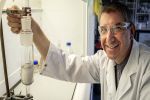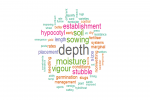Key points
Paving the way to autonomy involves:
- writing down why you want to embrace automation;
- documenting your on-farm processes;
- mapping how data flows through the business;
- communicating clearly with your staff; and
- engaging and upskilling your team.
An expert in digital agriculture and change management has reiterated the need for a farm audit as the first step in preparing a grains business for automation.
Dr Emma Leonard, founder of communications and change agency Agriknowhow, told a GRDC and Society of Precision Agriculture webinar that adopting automation was more than using a new piece of equipment.
“It requires a mindset change, taking time to think about on-farm processes, understanding how data flows through your systems and upskilling the team,” she said.
“While this might seem like an Olympian task, if we take a structured approach, hopefully, you will [win] gold medals.”
What is autonomy?
Dr Leonard said autonomy was the next stage in mechanisation, and automation was a stepping stone to autonomy.
She said on-farm jobs comprised tasks consisting of:
- diagnosing a problem or an opportunity;
- decision-making – gathering information to make a decision; and
- performing the task.
“But tasks rarely occur in isolation,” she said. “Multiple tasks join to become a process. And thinking about a process is essential when moving to automation and, eventually, autonomy.”
For example, Dr Leonard said most growers were likely no-till croppers who used specific processes related to soil and stubble management, weed control and seeding.
“Remember that tasks can be performed in different ways,” she said.
Traditionally, we executed tasks manually, such as writing a cheque to pay bills. But now we do this online, digitally.
As tasks become automated, she said diagnosis, decision-making and performance would be completed with models, sensors and machines. Examples include autosteer, variable-rate input applications and facial recognition.
“The more automated we become, the more critical connectivity becomes,” she said.
When a task is performed autonomously, there is minimal human involvement. However, Dr Leonard said robotic tractors pulling sprayers still required some tasks to be performed manually. One example is filling the sprayer.
Justify your why
Dr Leonard said automation could improve work–life balance, but there was no point in automating enjoyable tasks.
“There is value in writing down why you want to move the farm towards autonomy,” she said.
“Clearly explaining to another person why you want to change is essential. This is because communication and collaboration between managers across the team are critical in change management.”
She said change failed when people did not understand the benefits. “That is why it is important to articulate why you want to make a change.”
For example, Dr Leonard said she wanted to use fewer pesticides (fungicides and insecticides) to:
- reduce staff handling of pesticides;
- cut the number of machinery passes;
- reduce greenhouse gas emissions;
- increase market acceptance of grain;
- reduce environmental impacts; and
- lower costs.

SwarmFarm SwarmBot in a sorghum stubble paddock. Photo: Kirsty Fisher
Where to deploy?
The next step, Dr Leonard said, was considering where automation could be applied.
When moving towards autonomy, she said understanding all the steps in a process was crucial. “It is also essential to understand in which core functions the tasks in a process sit,” she said.
“From each task, data will flow, and the ability for it to move into different software without re-entry is vital.”
Dr Leonard classified the tasks and interoperable (exchangeable) data flows for disease control against the core functions of administration, production, resource management, and sales and marketing.
“As a process becomes more automated, data flow can be accessed by different software and applications. You might find it helpful to map your processes by creating diagrams.”
For example, she said employee occupational health and safety records needed to list what sprays had been applied so there were records if health issues arose.
Knowing where data flows to and from is also helpful. For instance, does it come from a physical location, satellites or sensors? Is it generated and used within the farm office, paddock or shed, or remotely by a third party?
“These questions must be considered before jumping into how to automate. To reduce fungicide inputs, I need technology to assist in automating the process.”
What to automate?
Dr Leonard said the next consideration was: ‘What jobs do I want to automate?’ “In simplistic terms, the technology must help achieve more appropriate and effective application,” she said.
 Source: Agriknowhow
Source: Agriknowhow
“More appropriate fungicide application means knowing whether the disease is present, at what crop growth stage, whether the control will be cost-effective, and if the forecasted conditions will likely exacerbate the disease level.
“More effective application is about ensuring only the parts of the crop that need to be sprayed are the only areas treated and fungicide application works.”
Unfortunately, she said, the technology to automate disease management was unavailable.
“That’s not bad because it allows me to identify where those data flows need to be and how the technologies under development might fit together.
“Eventually, we will be able to stitch all the bits together and embrace on-farm automation of disease management.”
Regarding what can be used now, she said she and her partner recently bought an automated fungal disease detection system called BioScout.
“Robots are now available for variable-rate spraying with section control. And other technologies are available that are improving the efficacy of spraying by moving pesticides deeper into the canopy.”
She said more technologies were coming but had yet to be made available.
Who will deploy?
Dr Leonard said people would still be needed in automated grain farms, but they would have different jobs.
“We will need people who know how to store and analyse data and those who know how to prepare autonomous equipment,” she said.
There will be more supervising and less sitting in tractors. And we will still need managers deciding where the robots will be deployed.
She said another consideration was having a change buddy. Research has shown that if somebody is responsible for overseeing a change, it is more likely to be successful.
“It’s hard work to change a family farming business, so I encourage people to think about working with a change buddy.
“Find somebody adopting a similar change you can work with. It might not be easy, but I hope that with Grain Automate, it might be something we can help with.”
Grain Automate is a five-year initiative developed by GRDC to accelerate the adoption of machine automation, autonomy and digital intelligence technologies by Australian grain growers. Dr Leonard also pointed to the value of upskilling staff so they were ready to take on the roles businesses would likely need.
More information: Emma Leonard, emma.leonard@bigpond.com
Resources:
Read more – Grain Automate
Watch the SPAA webinar – Paving the way for on-farm autonomy
Read more in GroundCoverTM story Disease surveillance automated
More GRDC precision ag resources

























































